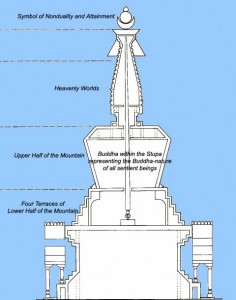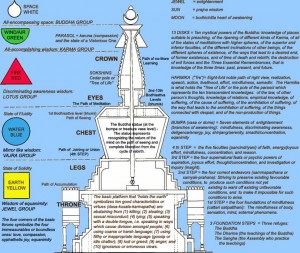A stupa (also knownn as pagodas, dagobas, or chortens) is a symbol of enlightenment and represents the mind of the buddhas. It represents the teachings or dharma of the Buddha on various levels. It is one of the most ancient icons of Buddhist art. Stupas are venerated Buddhist monuments or shrines frequently containing the relics (sharira) and sometimes the entire body of an enlightened being or other sacred objects. As such, they emanate blessings and peace. They vary in size and features. They often have a square base, a rounded or hemispherical midsection or dome, a tall conical upper section or spire and are topped with a crescent moon and a circular disc or sun, symbols used to represent the dharmakaya or Adharma Buddha. The shape can represent the Buddha, crowned and sitting in meditation posture on a lion throne. Overall they are used to symbolize the wisdom or mind of a Buddha.
The first Buddhist stupa was built according to the Buddha’s own instructions to house the remains of His chief disciple, Shariputra. The Buddha also gave instructions on how to construct a stupa for the veneration of His own relics. Literally “stupa” means heap or pile as the first stupas were simple burial mounds built to house holy relics.
Stupas were not only built as reliquary shrines, but were also built to commemorate the sites where events of spiritual significance took place. An example would be the stupa at Deer Park Monastery in Wisconsin that was built to commemorate the site of the first Kalachakra initiation given in the western hemisphere. Stupas are also built on geomantically significant spots as a stabilizing force, not only as a symbol but a veritable transmitter of enlightened mind. Through its design and contents, a stupa is regarded as having the power to transmit the essence of awakened mind, on the spot, to anyone ready to receive it.
One way of classifying stupas is according to the four major and four minor events in the life of the Buddha.
 H. H. Dilgo Khyentse Rinpoche: “Within the stupa the teacher remains unchanging. The Buddha said that whoever sees the stupa will be liberated by the sight of it. Feeling the breeze around the stupa liberates by its touch. Having thus seen or experienced the stupa, by thinking of one’s experience of it, one is liberated through recollection.”
H. H. Dilgo Khyentse Rinpoche: “Within the stupa the teacher remains unchanging. The Buddha said that whoever sees the stupa will be liberated by the sight of it. Feeling the breeze around the stupa liberates by its touch. Having thus seen or experienced the stupa, by thinking of one’s experience of it, one is liberated through recollection.”
“A stupa is a place where all the Buddhas are abiding. Those beings who don’t have the karma actually to see Buddha need the holy objects of body, speech and mind – statues, scriptures, stupas – as a field for accumulating merit.” – Guhyasamaja Root Text.”When a great teacher passes away, his body is no more, but to indicate that his mind is dwelling forever in an unchanging way in the dharmakaya, one will erect a stupa as a symbol of the mind of the Buddhas.”
Sharira
37 Factors of Enlightenment as Symbolized by the Stupa
Sutra on the Merit of Bathing the Buddha and Making Stupas
More information on locations and types of stupas on submenu on left.

